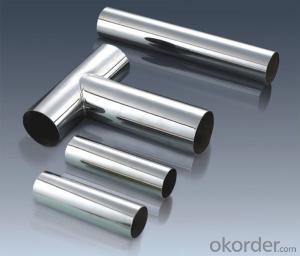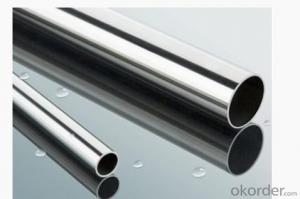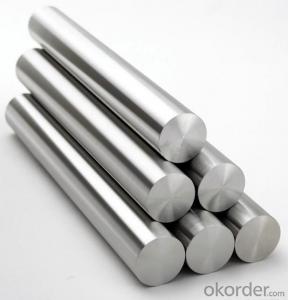Stainless Steel tube 304 with finest quality
- Loading Port:
- Shanghai
- Payment Terms:
- TT OR LC
- Min Order Qty:
- 1000 m.t
- Supply Capability:
- 1000000 m.t/month
OKorder Service Pledge
OKorder Financial Service
You Might Also Like
Stainless steel 304
Product Information of stainless steel:
- Width: customized
- Surface: 2B/BA/6K/8K/NO.4/HL.
- Thickness: 0.3mm - 3.0mm.
- Delivery time: 15-25 days.
- Length : As customer's requirement.
- Package: With export standard packing or customize packing.
- Payment Terms: T/T (30% deposit pay in advance and the balance before shipment) , irrevocable L/C.
Company advantage:
-Top Equipments, Leading In The Industry.
- Professional Team, Leading Innovation.
- Huge Supply Capacity Advantage, Timely and Effective Delivery.
- Modern Logistic, Fact and Convenient.
- Precise Manufacturing, Exquisite Products.
- Serve People, Create Value.
- Dimensional Network, Powerful Expansion.

- Q:What are the specifications for stainless steel pipes?
- The specifications for stainless steel pipes typically include the material grade, dimensions (such as outer diameter, wall thickness, and length), and specific standards or certifications they adhere to, such as ASTM, ASME, or EN. Additionally, specifications may also include information about the surface finish, type of joint or connection, and any special requirements for corrosion resistance or mechanical properties.
- Q:What is the difference between 904L and 316 stainless steel pipes?
- 904L and 316 stainless steel are both commonly used materials for pipes in various industries. The main difference between these two grades lies in their composition, properties, and applications. 1. Composition: - 904L stainless steel contains high levels of chromium, nickel, and molybdenum, along with copper. It has a higher alloy content compared to 316 stainless steel. - 316 stainless steel, also known as marine grade stainless steel, contains significant amounts of chromium, nickel, and molybdenum. However, it lacks copper in its composition. 2. Corrosion Resistance: - 904L stainless steel is highly resistant to corrosion, especially in aggressive environments such as seawater and acidic conditions. Its high chromium, nickel, and molybdenum content provide superior protection against pitting and crevice corrosion. - 316 stainless steel also offers excellent corrosion resistance, particularly in marine and chloride-rich environments. However, it is not as resistant to corrosion as 904L stainless steel. 3. Strength and Durability: - 904L stainless steel exhibits higher strength and durability compared to 316 stainless steel due to its higher nickel and molybdenum content. It can withstand higher pressures and temperatures, making it suitable for applications in extreme conditions. - 316 stainless steel possesses good strength and durability but is slightly lower in comparison to 904L stainless steel. 4. Applications: - 904L stainless steel pipes are commonly used in industries such as petrochemical, chemical processing, oil and gas, and marine applications. They are ideal for environments with high chloride levels and acidic conditions. - 316 stainless steel pipes are widely used in various industries, including food processing, pharmaceuticals, architecture, and marine applications. They are suitable for general-purpose applications where corrosion resistance is required but not as critical as in aggressive environments. In summary, while both 904L and 316 stainless steel pipes offer corrosion resistance, 904L stainless steel provides superior performance in aggressive environments due to its higher alloy content. However, 316 stainless steel is more commonly used in general-purpose applications where a high level of corrosion resistance is not essential.
- Q:What is the difference between the stainless steel tube and tube rolling
- Stainless steel stands for material. According to the production process, steel pipe, sub welded pipe, hot rolled pipe, cold rolled pipe and cold drawn pipe. What you say should refers to the cold drawn pipe drawing. Pipe called cold drawn, round steel called cold drawn. Compared with these processes, cold drawing and cold rolling are close to each other. The accuracy is higher, because of the plastic deformation, the mechanical properties are better. The specific difference is that the cold rolling is less than the cold drawn processing track, the accuracy and surface roughness are higher, and the processing cost is high. Cold drawing hardness is high, processing cost is low, processing will be wasted.
- Q:What's the difference between stainless steel 302 and 304?
- Plate type heat exchanger, corrugated pipe, household appliances (1, 2 kinds of tableware, kitchen cabinet, indoor pipeline, water heater, boiler, bath), auto parts (windshield wiper, muffler, mold), medical appliances, building materials, chemical, food industry, agriculture, marine parts, millet mobile phone etc.. 304 stainless steel is a nationally recognized food grade stainless steel.
- Q:Can stainless steel pipes be used for hydraulic systems?
- Yes, stainless steel pipes can be used for hydraulic systems. Stainless steel is a highly durable and corrosion-resistant material, which makes it suitable for use in hydraulic systems. It is capable of withstanding high pressure and extreme temperatures, making it a reliable choice for hydraulic applications. Stainless steel pipes also have excellent resistance to chemical and environmental factors, ensuring the longevity and reliability of the hydraulic system. Furthermore, stainless steel pipes offer excellent dimensional stability, which is crucial for maintaining the integrity and efficiency of the hydraulic system. Overall, stainless steel pipes are a popular choice for hydraulic systems due to their durability, corrosion resistance, and high performance capabilities.
- Q:Are stainless steel pipes suitable for brewery applications?
- Yes, stainless steel pipes are highly suitable for brewery applications. Stainless steel is corrosion-resistant, ensuring that the pipes can withstand the harsh chemicals and acids used in the brewing process. It is also easy to clean and maintain, making it ideal for maintaining the hygiene standards required in breweries. Additionally, stainless steel pipes do not impart any taste or odor to the beer, ensuring the quality and purity of the final product.
- Q:Are stainless steel pipes suitable for extreme temperatures?
- Yes, stainless steel pipes are suitable for extreme temperatures. Stainless steel is known for its excellent heat resistance properties, making it a popular choice for applications that involve high temperatures. Stainless steel pipes can withstand both extremely high and low temperatures, making them suitable for a wide range of industries such as oil and gas, chemical processing, power generation, and aerospace. The high chromium and nickel content in stainless steel alloys contribute to their ability to resist corrosion and oxidation, allowing them to maintain their structural integrity even under extreme temperature conditions. Additionally, stainless steel pipes have low thermal expansion and contraction rates, ensuring that they can withstand thermal cycling without significant distortion or damage. Overall, stainless steel pipes are a reliable and durable option for handling extreme temperatures.
- Q:Can stainless steel pipes be insulated with polyethylene terephthalate?
- Indeed, it is possible to insulate stainless steel pipes with polyethylene terephthalate (PET). PET is widely employed as an insulating substance owing to its low thermal conductivity, elevated melting point, and commendable resistance against moisture, chemicals, and UV radiation. It can be administered as a safeguarding layer or encircling the stainless steel pipes in order to avert heat loss or gain. The installation of PET insulation is straightforward and it proves highly efficient in minimizing energy transfer, thus rendering it appropriate for a multitude of applications in industries like HVAC, plumbing, and oil and gas.
- Q:What is the welding of stainless steel?
- If batch welding, it is recommended to use laser welding, welding heat affected area is small, weld appearance, speed, more suitable for thin plate,
- Q:How do you prevent vibration in stainless steel pipes?
- There are several measures that can be taken to prevent vibration in stainless steel pipes. 1. Use proper pipe supports: The selection and installation of appropriate pipe supports are crucial in preventing vibration. Ensure that the supports are designed to provide adequate stability and rigidity to the pipe system. This will help to minimize any potential movement or vibration. 2. Dampen vibrations with isolators: Install vibration isolators at strategic points along the pipe system. These isolators are designed to absorb and dampen vibrations, thereby reducing the transmission of vibrations through the stainless steel pipes. 3. Proper pipe alignment: Ensure that the pipes are properly aligned during installation. Misalignment can lead to stress concentrations and increased vibration. Proper alignment will help to distribute the forces evenly and reduce vibration. 4. Reduce fluid velocity: High fluid velocities can cause turbulence and induce vibrations in the pipe system. By reducing the fluid velocity through the pipes, you can minimize the occurrence of vibrations. This can be achieved by adjusting the flow rate or by using flow control devices such as throttling valves. 5. Soundproofing measures: In some cases, vibrations can be caused by external factors such as nearby machinery or equipment. Implement soundproofing measures to reduce the noise and vibrations generated by these sources. This can include using noise-absorbing materials or installing barriers to block or redirect the vibrations. 6. Regular maintenance and inspection: Regularly inspect the pipe system for any signs of vibration or wear. Address any issues promptly to prevent further vibration problems. Additionally, ensure that the pipe system is properly maintained, including regular cleaning and lubrication of any moving parts. By implementing these measures, you can effectively prevent vibration in stainless steel pipes, ensuring the overall stability and integrity of the pipe system.
1. Manufacturer Overview |
|
|---|---|
| Location | |
| Year Established | |
| Annual Output Value | |
| Main Markets | |
| Company Certifications | |
2. Manufacturer Certificates |
|
|---|---|
| a) Certification Name | |
| Range | |
| Reference | |
| Validity Period | |
3. Manufacturer Capability |
|
|---|---|
| a)Trade Capacity | |
| Nearest Port | |
| Export Percentage | |
| No.of Employees in Trade Department | |
| Language Spoken: | |
| b)Factory Information | |
| Factory Size: | |
| No. of Production Lines | |
| Contract Manufacturing | |
| Product Price Range | |
Send your message to us
Stainless Steel tube 304 with finest quality
- Loading Port:
- Shanghai
- Payment Terms:
- TT OR LC
- Min Order Qty:
- 1000 m.t
- Supply Capability:
- 1000000 m.t/month
OKorder Service Pledge
OKorder Financial Service
Similar products
New products
Hot products
Hot Searches
Related keywords
































